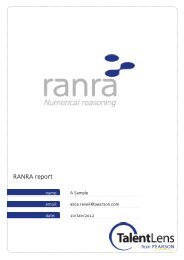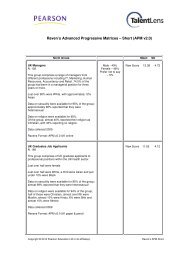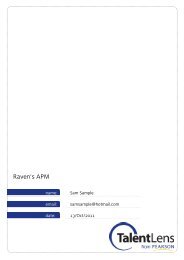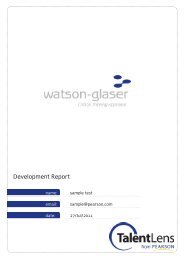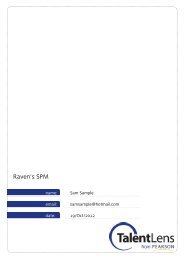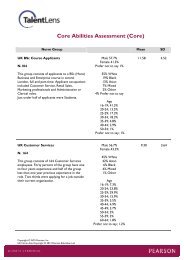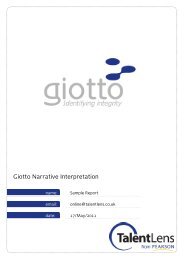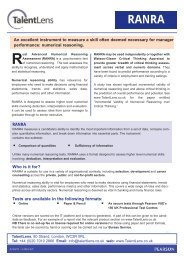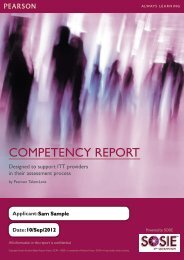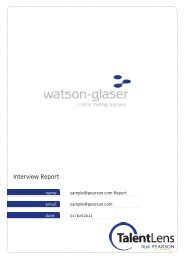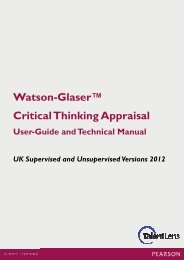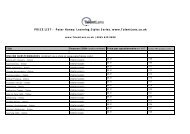Core Abilities Assessment: Evidence of Reliability and ... - TalentLens
Core Abilities Assessment: Evidence of Reliability and ... - TalentLens
Core Abilities Assessment: Evidence of Reliability and ... - TalentLens
- No tags were found...
Create successful ePaper yourself
Turn your PDF publications into a flip-book with our unique Google optimized e-Paper software.
<strong>Core</strong> <strong>Abilities</strong> <strong>Assessment</strong><strong>Evidence</strong> <strong>of</strong> <strong>Reliability</strong> <strong>and</strong> Validity888-298-6227 • <strong>TalentLens</strong>.comCopyright © 2007 NCS Pearson, Inc. All rights reserved.
Copyright © 2007 by NCS Pearson, Inc.All rights reserved. No part <strong>of</strong> this publication may be reproduced or transmitted in any form or by anymeans, electronic or mechanical, including photocopy, recording, or any information storage <strong>and</strong> retrievalsystem, without permission in writing from the copyright owner.Pearson <strong>and</strong> <strong>TalentLens</strong> logos are trademarks, in the U.S. <strong>and</strong>/or other countries, <strong>of</strong>Pearson Education, Inc. or its affiliate(s).Portions <strong>of</strong> this work were previously published.Printed in the United States <strong>of</strong> America.
<strong>Core</strong> <strong>Abilities</strong> <strong>Assessment</strong><strong>Evidence</strong> <strong>of</strong> <strong>Reliability</strong> <strong>and</strong> ValidityInternal Consistency <strong>Reliability</strong>The internal consistency reliability estimate for the <strong>Core</strong> <strong>Abilities</strong> <strong>Assessment</strong> total raw scorewas .85 in the st<strong>and</strong>ardization sample <strong>of</strong> 314 individuals. (See the Appendix for more detailsregarding the composition <strong>of</strong> the sample.) This reliability estimate indicates that the total rawscore on the <strong>Core</strong> <strong>Abilities</strong> <strong>Assessment</strong> possesses good internal consistency reliability asprovided in the guidelines <strong>of</strong> the U.S. Department <strong>of</strong> Labor (1999) for interpreting areliability coefficient.Content ValidityIn an employment setting, evidence <strong>of</strong> content validity is demonstrated by measuringcompetencies that are required for the job. The competencies measured by the <strong>Core</strong> <strong>Abilities</strong><strong>Assessment</strong> (i.e., general mental ability, inductive <strong>and</strong> deductive reasoning, verbal reasoning,numerical ability, <strong>and</strong> abstract reasoning) are required for a broad range <strong>of</strong> jobs. For example,the Department <strong>of</strong> Labor’s O*NET database lists over 500 jobs for which inductive reasoningability was rated as being important, very important, or critical for success (O*NET OnLine,2007). To confirm the relevance <strong>of</strong> the <strong>Core</strong> <strong>Abilities</strong> <strong>Assessment</strong> for the job you are hiring for,we recommend that you compare your job description <strong>and</strong> other sources <strong>of</strong> job information tothe competencies measured by the assessment. For legal defensibility, the assessment solutionmust show relevance for the position for which it is used.Convergent Validity<strong>Evidence</strong> <strong>of</strong> convergent validity is provided when scores on an assessment relate to scores onother assessments that claim to measure similar traits or constructs. Convergent validity for the<strong>Core</strong> <strong>Abilities</strong> <strong>Assessment</strong> is supported by part-whole correlations with the Differential AptitudeTests for Personnel <strong>and</strong> Career <strong>Assessment</strong> (DAT for PCA; Bennett, Seashore, & Wesman,1991), DAT for PCA convergent validity research, <strong>and</strong> results from the <strong>Core</strong> <strong>Abilities</strong><strong>Assessment</strong> st<strong>and</strong>ardization study.- 1 -Copyright © 2007 NCS Pearson, Inc. All rights reserved.
Part-Whole Correlations with the DAT for PCAConvergent validity for the <strong>Core</strong> <strong>Abilities</strong> <strong>Assessment</strong> is supported by correlations among <strong>Core</strong><strong>Abilities</strong> <strong>Assessment</strong> items <strong>and</strong> the DAT for PCA tests that the items were drawn from. Aspresented in Table 1, these correlations range from .85 to .90, providing evidence that theabbreviated item sets from the <strong>Core</strong> <strong>Abilities</strong> <strong>Assessment</strong> measure the same constructs as thecorresponding DAT for PCA full-length tests.Table 1. Correlations between <strong>Core</strong> <strong>Abilities</strong> <strong>Assessment</strong> <strong>and</strong> DAT for PCA Tests<strong>Core</strong> <strong>Abilities</strong> <strong>Assessment</strong>DAT for PCAItem Subset Number <strong>of</strong> Items Test Number <strong>of</strong> Items r part-wholeVerbal Reasoning 6 Verbal Reasoning 30 .87Numerical Ability 7 Numerical Ability 25 .90Abstract Reasoning 7 Abstract Reasoning 30 .85Note. n = 569 for Verbal Reasoning correlation; n = 1057 for Numerical Ability correlation; n = 1695 for AbstractReasoning correlation. All correlations are significant at the .001 level.DAT for PCA Convergent Validity StudiesYears <strong>of</strong> previous studies on the DAT for PCA support its convergent validity, <strong>and</strong> by extension,the convergent validity <strong>of</strong> the tests comprising the <strong>Core</strong> <strong>Abilities</strong> <strong>Assessment</strong>. For example,scores on the DAT Verbal Reasoning <strong>and</strong> Numerical Ability composite correlate in the range <strong>of</strong>.38 to .79 with SAT scores <strong>and</strong> .68 to .94 with ACT scores (Bennett, et al., 1991). Similarly, DATAbstract Reasoning scores correlate highly with general mental ability scores on assessmentssuch as the General Aptitude Test Battery (r = .64 with General Learning Ability) <strong>and</strong> the ArmedServices Vocational Aptitude Battery (r = .69 with the Armed Forces Qualification Test).- 2 -Copyright © 2007 NCS Pearson, Inc. All rights reserved.
<strong>Core</strong> <strong>Abilities</strong> <strong>Assessment</strong> St<strong>and</strong>ardizationStudy — Convergent ValidityThe <strong>Core</strong> <strong>Abilities</strong> <strong>Assessment</strong> st<strong>and</strong>ardization study provides further evidence for theassessment’s convergent validity. In the st<strong>and</strong>ardization study, <strong>Core</strong> <strong>Abilities</strong> <strong>Assessment</strong>scores correlated .84 with Wonderlic Personnel Test scores (Wonderlic, 1992; n = 205) <strong>and</strong> .56with Differential Aptitude Test Mechanical Reasoning scores (DAT MR; Bennett, et al., 1991; n =123). The Wonderlic Personnel Test, like the <strong>Core</strong> <strong>Abilities</strong> <strong>Assessment</strong>, measures generalmental ability, <strong>and</strong> the DAT MR measures mechanical aptitude, which typically correlatesmoderately to strongly with general mental ability (Bennett, 2006).Criterion-Related ValidityCriterion-related validity addresses the inference that individuals who score better on anassessment will be more successful on some criterion <strong>of</strong> interest. Criterion-related validity forthe <strong>Core</strong> <strong>Abilities</strong> <strong>Assessment</strong> is supported by three lines <strong>of</strong> research, including validitygeneralization, DAT for PCA criterion-related validity studies, <strong>and</strong> the <strong>Core</strong> <strong>Abilities</strong> <strong>Assessment</strong>st<strong>and</strong>ardization study.Validity GeneralizationCriterion-related validity for general mental ability tests like the <strong>Core</strong> <strong>Abilities</strong> <strong>Assessment</strong> issupported by validity generalization. The principle <strong>of</strong> validity generalization refers to the extentthat inferences from accumulated evidence <strong>of</strong> criterion-related validity from previous researchcan be generalized to a new situation.There is abundant evidence that measures <strong>of</strong> general mental ability, such as the <strong>Core</strong> <strong>Abilities</strong><strong>Assessment</strong>, are significant predictors <strong>of</strong> overall performance across jobs. For example, in itspublication on the Principles for the Validation <strong>and</strong> Use <strong>of</strong> Personnel Selection Procedures, theSociety for Industrial <strong>and</strong> Organizational Psychology (2003) notes that validity generalization iswell-established for cognitive ability tests. Schmidt & Hunter (2004) provide evidence thatgeneral mental ability “predicts both occupational level attained <strong>and</strong> performance within one’schosen occupation <strong>and</strong> does so better than any other ability, trait, or disposition <strong>and</strong> better thanjob experience” (p. 162). Prien, Schippmann, <strong>and</strong> Prien (2003) observe that decades <strong>of</strong>research “present incontrovertible evidence supporting the use <strong>of</strong> cognitive ability acrosssituations <strong>and</strong> occupations with varying job requirements” (p. 55). Many other studies provideevidence <strong>of</strong> the relationship between general mental ability <strong>and</strong> job performance (e.g., Kolz,- 3 -Copyright © 2007 NCS Pearson, Inc. All rights reserved.
McFarl<strong>and</strong>, & Silverman, 1998; Kuncel, Hezlett, & Ones, 2004; Ree & Carretta, 1998; Salgado,et al., 2003; Schmidt & Hunter, 1998; Schmidt & Hunter, 2004).DAT for PCA Criterion-Related Validity StudiesIn addition to inferences based on validity generalization, findings from numerous studiesprovide evidence <strong>of</strong> criterion-related validity for the DAT for PCA tests that compose the <strong>Core</strong><strong>Abilities</strong> <strong>Assessment</strong>. For example, <strong>of</strong> the 36 uncorrected validity coefficients obtained across15 studies on DAT Verbal Reasoning (Bennett, et al., 1991), all met the U.S. Department <strong>of</strong>Labor (DOL) criterion (1999) for an assessment that is “likely to be useful” (i.e., validitycoefficients ranging from .21 to .35) <strong>and</strong> 20 met the highest DOL st<strong>and</strong>ard, “very beneficial”(i.e., validity coefficients greater than .35). Similarly, for DAT Numerical Ability, 29 <strong>of</strong> 29uncorrected validity coefficients obtained across 13 studies met the DOL “likely to be useful”criterion, <strong>and</strong> 11 met the highest st<strong>and</strong>ard <strong>of</strong> “very beneficial.” For DAT Abstract Reasoning, 24<strong>of</strong> 24 uncorrected validity coefficients obtained across 21 studies met the DOL “likely to beuseful” criterion, <strong>and</strong> 16 met the highest st<strong>and</strong>ard <strong>of</strong> “very beneficial.” The DAT for PCA Manual(Bennett, et al., 1991) provides additional details on these studies.<strong>Core</strong> <strong>Abilities</strong> <strong>Assessment</strong> St<strong>and</strong>ardizationStudy — Criterion-Related ValidityThe <strong>Core</strong> <strong>Abilities</strong> <strong>Assessment</strong> st<strong>and</strong>ardization study provides further evidence for theassessment’s criterion-related validity. In the st<strong>and</strong>ardization study, <strong>Core</strong> <strong>Abilities</strong> <strong>Assessment</strong>scores correlated .32 (uncorrected) with supervisor ratings <strong>of</strong> problem-solving behavior for agroup <strong>of</strong> 115 plant mechanics at a national manufacturing company.Importance <strong>of</strong> Local ValidationThe validity information presented in this guide is not intended to serve as a substitute for locallyobtained validity data. Local validity studies, together with locally derived norms, provide asound basis for determining the most appropriate use <strong>of</strong> <strong>Core</strong> <strong>Abilities</strong> <strong>Assessment</strong> scores.Therefore, whenever technically feasible, users <strong>of</strong> the <strong>Core</strong> <strong>Abilities</strong> <strong>Assessment</strong> should studythe validity <strong>of</strong> the assessment at their own location or organization.- 4 -Copyright © 2007 NCS Pearson, Inc. All rights reserved.
Description <strong>of</strong> the SampleAppendixThe information provided in the following tables is based on <strong>Core</strong> <strong>Abilities</strong> <strong>Assessment</strong> datacollected during the period December, 2006 through June, 2007.Appendix 1. Composition <strong>of</strong> the Sample by Job Title (n = 288*)OccupationAdministrative Assistant 2.1%Clerk 2.1%Engineer 1.0%Human Resources Occupations 1.0%Information Technology Occupations 1.0%Maintenance 2.1%Manager 3.8%Operations Planner 1.0%Plant Mechanic 67.7%Purchasing 1.4%QC Specialist 1.4%Sales Representative (Non-Retail) 5.2%Supervisor 4.2%Team Leader 1.0%Vice President 1.0%Other 4.0%*Twenty-six individuals did not provide a response about their job title.- 5 -Copyright © 2007 NCS Pearson, Inc. All rights reserved.
Appendix 2. Composition <strong>of</strong> the Sample by Position Level (n = 288*)Position LevelExecutive; Director 1.4%Manager 3.8%Supervisor 4.2%Pr<strong>of</strong>essional/Individual Contributor 13.9%Skilled Trades 71.9%Hourly/Entry-Level 4.9%*Twenty-six individuals did not provide a response about their position level.- 6 -Copyright © 2007 NCS Pearson, Inc. All rights reserved.
ReferencesBennett, G. (2006). Bennett Mechanical Comprehension Test manual. San Antonio, TX:Pearson Education, Inc.Bennett, G., Seashore, H., & Wesman, A. (1991). Technical manual for the DifferentialAptitude Tests for Personnel <strong>and</strong> Career <strong>Assessment</strong>. San Antonio, TX:The Psychological Corporation.Kolz, A. R., McFarl<strong>and</strong>, L. A., & Silverman, S. B. (1998). Cognitive ability <strong>and</strong> job experience aspredictors <strong>of</strong> work performance. The Journal <strong>of</strong> Psychology, 132(5), 539–548.Kuncel, N. A., Hezlett, S. A., & Ones, D. S. (2004). Academic performance, career potential,creativity, <strong>and</strong> job performance: Can one construct predict them all? Journal <strong>of</strong>Personality <strong>and</strong> Social Psychology, 86(1), 148–161.O*NET OnLine (2007). Welcome to O*NET OnLine! Making occupational informationinteractive <strong>and</strong> accessible to all. Occupational Information Network: O*NET OnLine.Retrieved July 25, 2007 via O*NET OnLine Access: http://online.onetcenter.orgPrien, E. P., Schippmann, J. S., & Prien, K. O. (2003). Individual assessment as practiced inindustry <strong>and</strong> consulting. Mahwah, NJ: Erlbaum.Ree, M. J., & Carretta, T. R. (1998). General cognitive ability <strong>and</strong> occupational performance. InC. L. Cooper & I. T. Robertson (Eds.), International review <strong>of</strong> industrial <strong>and</strong>organizational psychology (Vol. 13, pp. 159–184). Chichester, Engl<strong>and</strong>: Wiley.Salgado, J., Anderson, N., Moscoso, S., Bertua, C., & Fruyt, F. (2003). International validitygeneralization <strong>of</strong> GMA <strong>and</strong> cognitive abilities: A European community meta-analysis.Personnel Psychology, 56, 573–605.Schmidt, F. L., & Hunter, J. E. (1998). The validity <strong>and</strong> utility <strong>of</strong> selection methods in personnelpsychology: Practical <strong>and</strong> theoretical implications <strong>of</strong> 85 years <strong>of</strong> research findings.Psychological Bulletin, 124, 262–274.Schmidt, F., & Hunter, J. (2004). General mental ability in the world <strong>of</strong> work: Occupationalattainment <strong>and</strong> job performance. Journal <strong>of</strong> Personality <strong>and</strong> Social Psychology,86(1), 162–173.Society for Industrial <strong>and</strong> Organizational Psychology. (2003). Principles for the validation <strong>and</strong>use <strong>of</strong> personnel selection procedures (4 th ed.). Bowling Green, OH: Author.- 7 -Copyright © 2007 NCS Pearson, Inc. All rights reserved.
U.S. Department <strong>of</strong> Labor. (1999). Testing <strong>and</strong> assessment: An employer’s guide to goodpractices. Washington, DC: Author.Wonderlic, E. F. (1992). Wonderlic Personnel Test & scholastic level exam user’s manual.Libertyville, IL: Wonderlic Personnel Test.- 8 -Copyright © 2007 NCS Pearson, Inc. All rights reserved.




